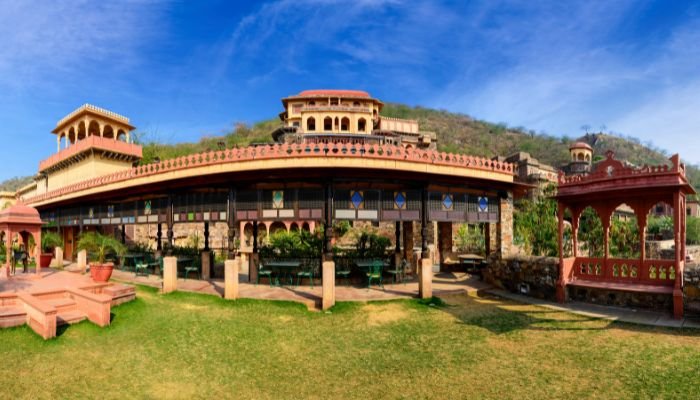Here’s the Neemrana Fort Palace guide for tourists. Know about the Neemrana Fort Palace: history, images, and more!

Concealed and trapped on a canted hill in a wooded glade of Kot Behror, a foregone town of Alwar district, on the Delhi – Jaipur highway {147 km from Jaipur & 121 km from New Delhi}; yet once undisclosed commands unblinking attention from all those who lay their eyes upon it, Neemrana Fort Palace is a recondite site of intrigue, inspiration and invigoration.
Given the name, either after a chieftain Nimola Meva, or after ‘Neem’ trees; the foundations of the palace were supposedly erected in 1464 CE, under the reigns of the ‘Chauhans of Alwar’, and held by the kinship of Prithviraj Chauhan III until 1947. The fort-palace which must have been a formidable force in its time began wearing down to ruins, when it was acquired by Aman Nath & Francis Wacziarg, two messianic architectural restorers & hoteliers, who saved it from meagerly becoming a shadow of its former greatness, under their flagship hospitality brand – ‘Neemrana Hotels’.

Restored, refurbished, uplifted and aggrandized, the Neemrana Fort Palace magically resurrected like a phoenix from its own rubble, has been operating as one of India’s best luxury heritage hotels since 1991. The castle-like spread over more than 10 acres, in 14 tiered levels cut into the hill, and sectioned into 9 wings, has been painstakingly amped up with some definite Rajput, Mughal and European designs that would meld with the already extant dilapidated forms, to imitate undertones, moods, atmosphere and aura of the 15th century as a pie-in-the-sky.
Moving into the fortification when the gigantic doors are prised open, at a stroke feels like walking into a centuries-old fabledom as meek subjects who are endlessly filled with amazement. In a lighter vein referred to as ‘Neemranification’, the multi-crore valued renovation project has successfully tucked in place about 80 rooms/suites, swimming pools, health spa, hanging gardens, open-air and in-house restaurants, conference halls, an amphitheatre, a gymnasium, private balconies in some portions, turrets, spiral staircases, tunnels, verandahs and multiple terraces, all of which promise to fill one’s heart with undiluted views of the timeless property and the circumjacent environs.

A true medieval escapade in every sense, Neemrana boosts itself as a ‘non-hotel’ hotel experience for visitors by providing refined services through its well-trained staff – walking tours around the spic-n-span resort, a sumptuous spread of versatile buffets, and hosting unforgettable cultural extravaganzas. It is quite natural to wonder while wandering inside the imperial quarters if fairy tales are for real. Literally a ‘castle in the air’, Neemrana fort wears its age with grace. Equipped with only two elevators (only for certain levels), the visitors are expected to be physically fit in so as to get lost in the labyrinth of corridors, get drenched in history as they scale hilly heights, chase sunbeams through the elegance of archways, and discover stories written in stone in the tangled maze of subterranean passageways.
Reserve an antique-styled suite to stay at the monumental property or make a short day trip to dine at one of their classic café-bars if from a nearby place, either way be rest assured to feel like a king at least for a day! Not just that, be it posh weddings, business meets or film shoots, Neemrana has become the destined venue for all kinds of memorable events.
In addition, guests at Neemrana can revel in the pleasure of other bonus attractions/activities, say camel rides, vintage car rides or even hiking up to the nearby ‘step well’{18th century}.

Today, with a bag full of accolades, Neemrana Fort that luminesces in enrapturing ochre and tawny shades at sunrise/sunset, pompously stands out as a foremost shining example of a lucid historical wonder not just ignored to dust, but ingeniously woken up from the dead and infused life by remodelling as a staggering modern day ‘heritage’ spectacle!
Further into the bargain, the Neemrana group has gone ahead with similar preservation efforts thru’ hotel conversion measures in a lot of other ancient as well as colonial sites of our country such as Tijara Fort Palace, Alwar (19th century), Kesroli Fort Palace, Alwar (14th century), Deo Bagh, Gwalior (17th century), Baradari Palace, Patiala (19th century), Tower House, Cochin (17th century) and Bungalow on the Beach, Tranquebar (17th century), to name a few.
